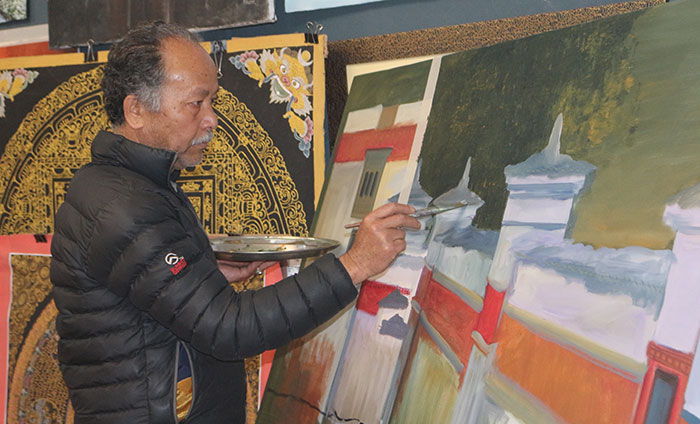Chhimi Dema
Sukbir Bishwa, 60, from Samtse, is one of the most seasoned artists in the country today. His area of interest and specialisation is contemporary Bhutan.
Friends know Sukbir as witty and fun-loving. In his hands, colours speak. He paints the world around him as is it — people, architectures and landscapes — in their sublime state.
Talk about how appreciation has grown in Bhutan over the years, Sukbir say it took a lot of hard work. “Artists weren’t appreciated; art did not have a market.”
In 1994, or thereabouts, Sukbir took two of his paintings to sell to an owner of a popular restaurant in Thimphu. After much bargaining, he could sell his paintings for Nu 3,000 and a whole tandoori (roasted) chicken. “They were worth Nu 7,000 even then.”

But he kept going, undaunted, inspiring younger Bhutanese artists along the way.
VAST’s Kama Wangdi, a good friend of Sukbir, said: “What I like about Sukbir is his determination. He once told me that Bhutan would one day be flooded with his paintings. And it came true! Go anywhere today and you’ll find his painting in most of the guesthouses and hotels.”
Sukbir was, according to Kama Wangdi, one of the earliest contemporary painters in the country. “When he began exhibiting his work, we’d barely any idea of exhibition.”
In the late 1990s, Karma Wangdi and Sukbir did a project together for World Wildlife Fund.
“I was barely a teen when I saw my uncle sketching and drawing,” Sukbir says. “I was fascinated by what he made out of simple sketches.”
Then came one Mr Singha in his school days, who left a lasting impression on young Sukbir. Mr Singha was a teacher from Haryana, India. He would paint on weekends and exhibit his work in his house.
As a student, Sukbir took part in many art competitions. He was 13 when he received a certificate of merit from Shankar’s International Children’s Competition.
One of the biggest influences on Sukbir, in his school days, was David Piper’s Painting in England (1500-1880). The paintings in the book were in black and white and resembled the way of life in the southern parts of Bhutan.
He copied Thomas Gainsborough’s Sportsman with Two Dogs in a Landscape, on cardboard and hung it on the wall of his classroom. “Everybody liked it. Children from other classes came to see it like it was an exhibition. It was a thrilling moment for a young boy.”
Back in Sherubtse public school (now Sherubtse College) in Trashigang, Sukbir’s free time was spent drawing for his friends. “My friends used to bring photographs of their girlfriends and ask me to draw in their slam books to impress them,” he says. “That was an opportunity to master my skills.”
In 1989, Sukbir held an exhibition in the Voluntary Service Overseas (VSO) office—international development charity to empower communities in developing countries—in Thimphu. It was a life-changing event for a young man, who had by then mastered hard and subtle ways of painting.
Many expatriates bought his work. When the hotel industry began to develop rapidly in mid-1990, Sukbir found a steady source of income from selling his artworks.
What would you have done had it not been for art? Sukbir was an accountant in a government office before he resigned in 2009 to take up art professionally.
If you happen to visit Artyantra in Changzamtog, Thimphu, you’ll find a man smeared in colours, any time of the day, paintbrush tucked behind his ears, studying landscape photographs. This is Sukbir Bishwa and he will look at you as though you were a piece of art in front of him.
In a way, for him, we are.


